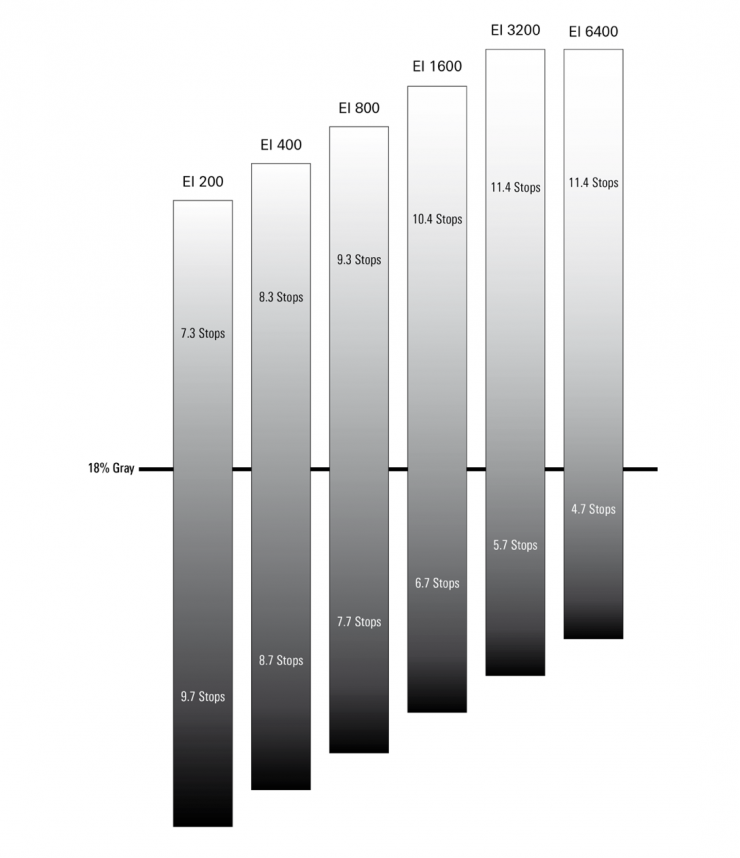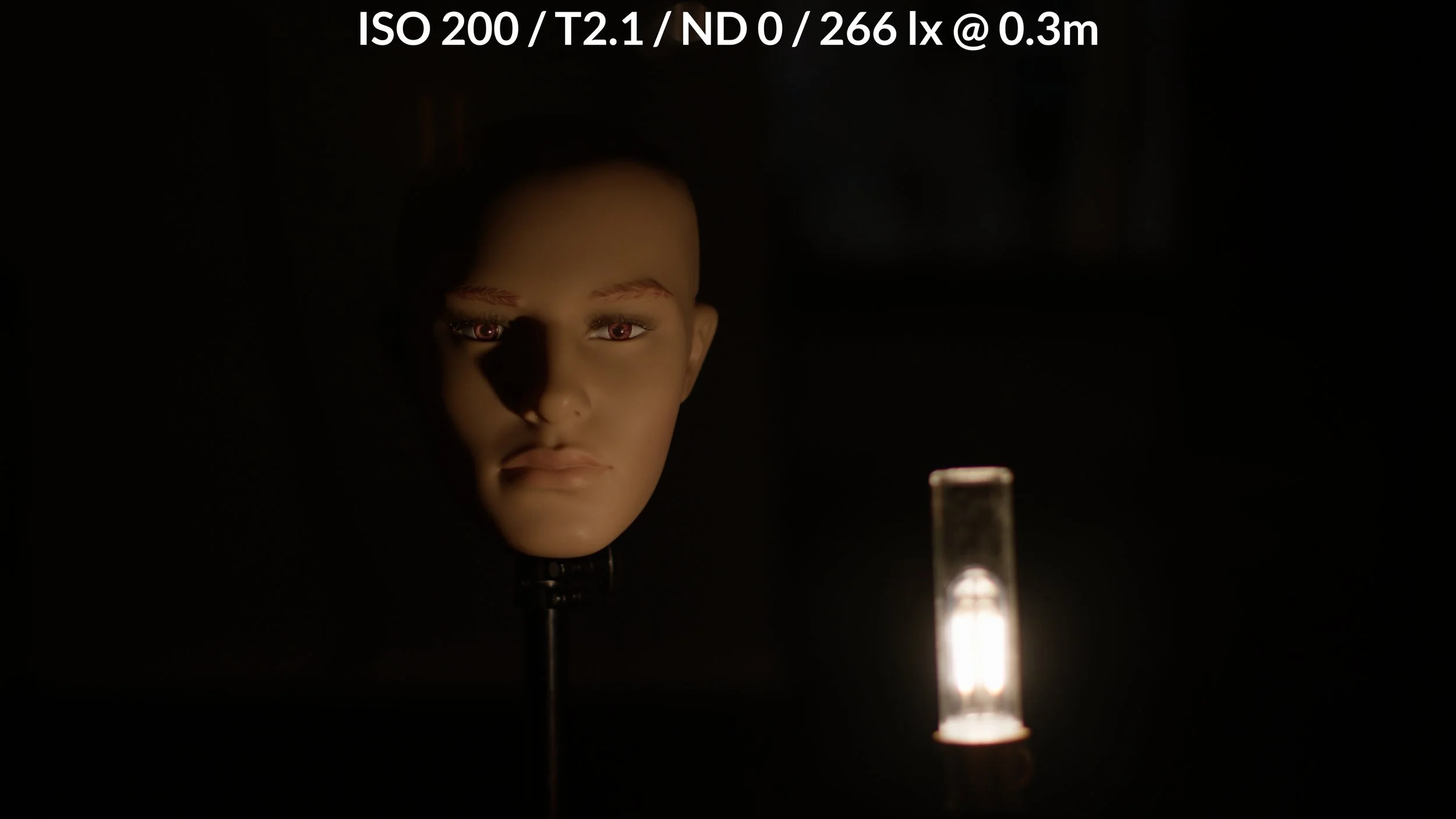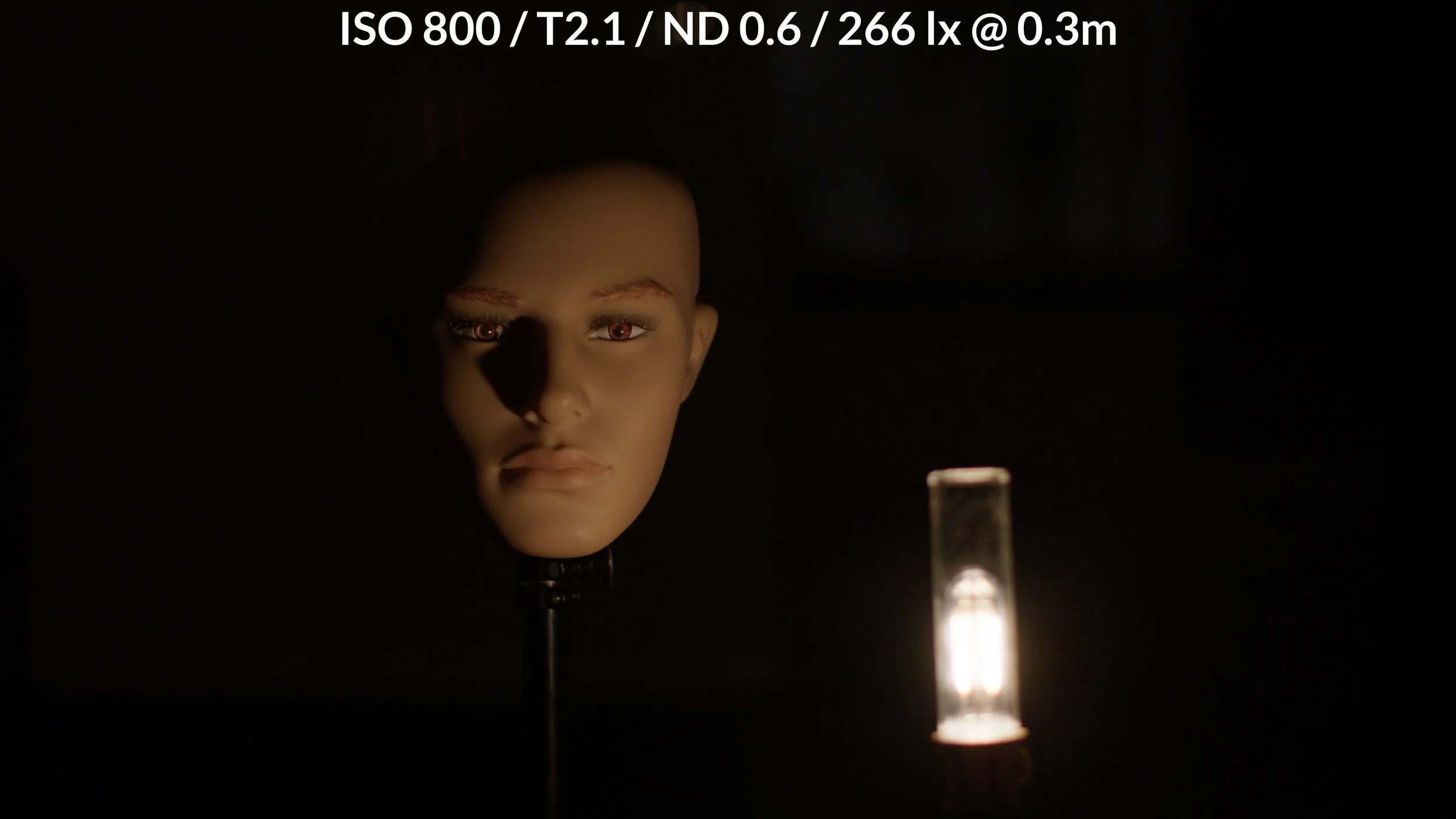Low light filming with Alexa 35
A lit match is held in front of Ken (a mannequin) to illustrate low light filming. [Alexa 35, EI/ISO 400, T2.1, 2500K, K445 Default texture]
Introduction
Recently I was asked by a colleague of mine if it would be possible to film in dark spaces only being lit by an oil lamp. How would shadow areas in particular hold up in these kind of scenes where the sensor is really getting a limited amount of light. The question was primarily asked in the context of using the Alexa 35 camera and evaluating whether it performs effectively when filming in low light conditions. This was a great question and actually something I have wanted to test for a long time, not how ISO changes the captured image but rather how EI/ISO changes the distribution of available stops (exposure) above and below 18% grey, essentially your highlights and shadows respectively.
As a result two questions came to mind:
If the scene is lit in the same way, using the same T-stop but modifying EI/ISO and ND to maintain what I expose the sensor in the same way, how does the image itself change (if at all) and does the distribution of stops actually make a perceived difference in the image?
Do I get a much smoother gradient and falloff from illuminated areas all the way into black when filming at low EI/ISO values such as 200 rather than 6400ES?
I have read a lot of white papers over the years describing how raw and non-raw codecs work in relation to the distribution of stops across a specific cameras total dynamic range. In a very simplified manner (and this might not apply to all sensors and manufacturers) the sensor has one sensitivity and a specific dynamic range before the signal clips in the highlights and before it disappears in the noise floor in the shadows. Raw formats generally have more information stored from a single frame than compressed formats, with the added benefit of being able to modify metadata such as ISO or white balance after the fact that the image is captured (formats like ProRes does not allow for this). The image however is captured in a specific lighting condition and by shifting ISO after the fact does not inherently make the scene brighter - but it does shift the distribution of what is in that single frame. A frame filmed at ISO200 with ARRIRAW brought up to ISO 6400 will introduce noise in the shadows and potentially blow the highlights. The image will perceptually look brighter but at the cost of introduced noise and a re-distribution of stops that might not match the original creative intent. Conversely, a high key scene would benefit from a higher ISO as there are more stops to distribute within the specified dynamic range. Lastly, distribution of stops in non-raw formats such as ProRes have the limitation that it is baked into the file.
To summarise, EI/ISO changes the distribution of dynamic range between highlights and shadows, it does not inherently make a scene brighter. You still need to light the scene in the way you want it to look.
In the test I brought out Ken, the light head. He has served me well as a stand-in for a long time! I purchased an oil-lamp look-alike with a warm-light bulb that would simulate fire. As a reference a single candle emits about 11-13 lumens and an oil lamp between 10-100 lumens. The range for this modern USB-C charged oil lamp spans from 10-175 lumens (from low to max setting according to specifications). When measured in lx (Lux) at the distance from the light source to Kens face (approximately 30 cm) the light meter reported 12lx (left image) and 266lx (right image) respectively (low and high setting).
For reference, what is lux and lumen?
Lumens (lm) measure the total amount of visible light emitted by a source (its brightness), while lux (lx) measures the amount of light that falls onto a surface (light intensity or illuminance), where 1 lux equals 1 lumen per square meter. Think of lumens as how much water flows from a hose, and lux as how much of that water hits a specific area on the ground. Reference.
Alexa 35 highlight and shadow distribution across EI/ISO values.
In the test I recorded the same scene across ISO 200-400-800-1600-3200ES-6400ES (essentially doubling from the previous setting) while maintaining the exposure level at ISO 200 by introducing ND 0.3 at ISO 400, ND 0,6 at ISO 800, ND 0,9 at ISO 1600, ND 1,2 at ISO 3200ES and ND 1.5 at ISO 6400ES.
It was done this way because I wanted to see how the distribution of highlights and shadows would change across the EI/ISO levels and if it would have any perceptual impact on the image.
As mentioned in the ARRI white paper “Low light shooting” it is recommended to use the following textures at EI/ISO 2560/3200/6400:
When shooting moderately dark scenes, choose EI 2560 with Enhanced Sensitivity enabled and the L345 Shadow Texture
When shooting dark scenes, choose EI 3200 with Enhanced Sensitivity enabled and the L345 Shadow Texture
When shooting in extreme low light or no light conditions, choose EI 6400 with Enhanced Sensitivity enabled and the H457 Deep Shadow Texture
Equipment used for the test
In the test I used the ARRI Alexa 35 (firmware 5.1.0) paired with a Schneider Kreuznach FF 75mm lens at T2.1.
For ND-adjustments I used the built-in ND together with an ARRI FSND 0.3 to be able to make the incremental steps at ND 0.3, 0.9 and 1.5.
K445 Default texture was used in the range of EI/ISO 200-1600, L345 Shadow Texture was used at EI/ISO 3200 and H457 Deep Shadow Texture for EI/ISO 6400.
Stills were converted in Davinci Resolve Studio 20.2.2 using a CST (Color Space Transform) from LogC4 to Rec.709.
False colour representations are based on the above image stills after LogC4 to Rec.709 conversion.
My conclusion from these initial frames by comparing the image itself (at each EI/ISO) and their respective response in false colour is the following:
Low EI/ISO results in smoother gradients across exposure levels. The image is also very clean with no to little texture or noise. When compared to EI/ISO 6400ES the texture/noise is very visible, both in the gradual falloff in the face and in areas in the background in the image. Details are better preserved at low EI/SO and the waveform is cleaner. In quick tests in Davinci Resolve where I made adjustments by modifying where shadows sit there seemed to be more headroom to do so compared to the image captured at EI/ISO 6400ES.
I was expecting to see more gradients from illuminated areas into darkness and it is only when shifting from a sharp to smooth color transition within the False Color plugin OFX - namely how the false color interprets the image that this becomes more apparent (see below). There could potentially be more information visible if a LOG-image was analysed and other conclusions drawn from that. For instance, a LOG image could very well hold information across 17 stops but is then compressed into 5-6 stops that Rec.709 holds. As such, images that actually carry information in the deep shadows don’t necessarily have to be pitch black. In this test however I have been looking at dynamic range distribution given the same circumstances across different EI/ISO levels.
Below is the waveform from a LogC4 to Rec. 709. converted image. Noticeably there is much more distribution across shadows and highlights at low EI/ISO and seemingly less at high EI/ISO. Especially if you compare the low light shot: 1st image top row versus 5th image bottom row. Additionally the shadows are lifted significantly at higher EI/SO as seen in the last four images in the bottom row (representing EI/ISO 3200 and 6400).
Looking at the LOG waveform noise distribution in the dark areas of the images are significantly scattered whereas appearing very clean in low EI/ISO. Highlights in the shots with the oil lamp at high output reaches higher and higher as the EI/ISO is increased (see below). Since this waveform is looking at the LOG image we can see the distribution much clearer here as it is not as compressed in the bottom as seen in the previous set of waveforms (see below).
Now you could of course also use EI/ISO as a way to perceptually brighten up the image and what we see in the frame without really taking into account highlight/shadow distribution - as a creative method or a way to bake in texture into the image. In that case the signal is essentially only boosted. Then again, if detail in the shadows is what matters then lower EI/ISO should be preserved instead of highlights at high EI/ISO. See below images for comparison with their individual waveforms.
Conclusions and further thoughts
I’m trying to get the terminology correct here but I think it is safe to say that the sensor has a “single” sensitivity that can be distributed across different EI’s (exposure index). Depending on the exposure index the highlights and shadows are distributed differently with EI/ISO 800 being a balanced point between them two.
For all intents and purposes, filming in low light at low EI/ISO preserves shadow detail but at the expense of perceived brightness, this also preserves a clean signal. If a low light scene is filmed at high EI/ISO then shadow details are boosted and noise/texture is introduced. This can be reduced by using ES-mode on the Alexa 35 which essentially is an in-camera denoiser (see page 5 in ARRI white paper on Low Light Shooting) and improved by using textures that are specific for high EI/ISO.
While there isn’t a single conclusion about how to use a camera in low light scenes it can certainly be used in these scenarios. Another aspect that has not been mentioned here is that optics has a major impact on the amount of light that will hit the sensor. That relationship is probably even more important as it defines how much or little light you actually need within a scene to begin with. In this test I used a lens with maximum T-stop of 2.1, for a full stop difference you would have to go to T1.4. Understanding how the camera behaves and what amount of light you need to feed it to expose for an image is one thing - the creative choice how you distribute exposure across the image and within what levels is another thing to consider.
In the end you still need to light a scene as you envision it to be.
Do reach out with comments, feedback or suggestions to this article. Send me an email: michael@michaeltebinka.com
Edited 20251103: Sentences paraphrased, clarifications in descriptions and spacing added.
Edited 20251102: Added non-CST (color space transform) false color images with smooth gradients to better illustrate fall-off from light to dark.












































































